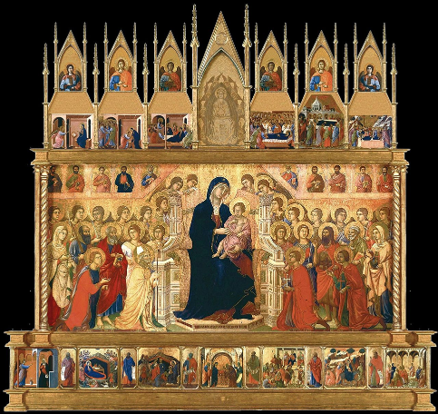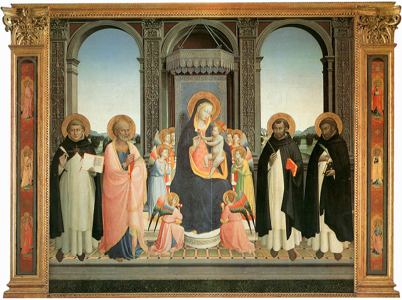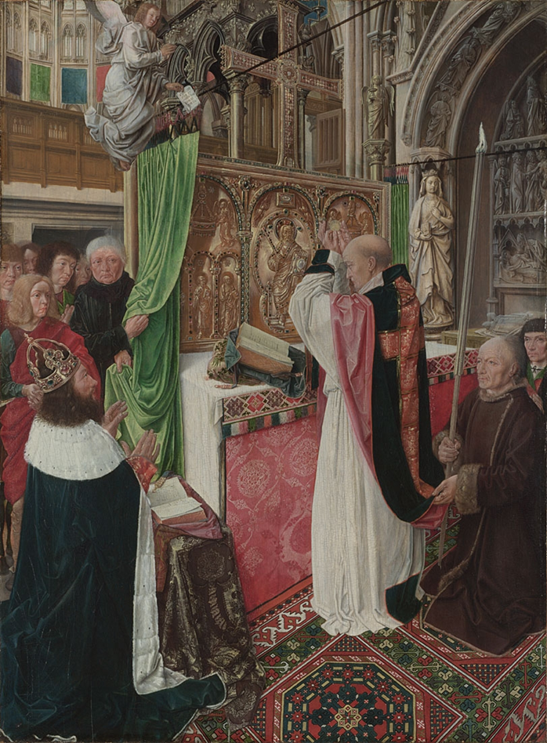Lecture 6: Tradition and Innovation in the Italian Renaissance Altarpiece
1/9
There's no tags or description
Looks like no tags are added yet.
Name | Mastery | Learn | Test | Matching | Spaced |
|---|
No study sessions yet.
10 Terms
Key Ideas
The functional nature of altarpieces (NOT for Art’s sake)
Should not divorce them from their original, site-specific context
Engagement w/ the altarpiece during religious rites
The stylistic evolution of the altarpiece to fit Middle Ages —> Renaissance ideals
(A) As its contexts of usage changed (e.g. position of the priest; congregation size)
(B) To become more affective & effective religious objects; new dramatic force
Polyptych
Predella
Pala
Definitions
Altarpiece
Function
Types
Altar
Function
Design
Altarpiece
An image-bearing structure, e.g:
Tapestry
Painting
Sculpture
Set upon/abutting the back of the altarblock
Site-specific
Functional; NOT made for art’s sake (e.g. to be hung up as decoration)
Sometimes is also called a retable
Types:
Side altar (donated by private patrons)
High altar (donated by priests, etc.)
Where the altarpiece would be positioned depended on the patron’s status
Altar
A table/similar raised structure
For sacrificial, Eucharistic or other religious purposes
E.g. the tomb of Christ
E.g. the table from the Last Supper
The altar makes the altarpiece ⭐
An altar DOESN’T always require an altarpiece, but an object can’t be considered an altarpiece if it was never used in an altar
Typical design:
Words often inscribed along the peripheral of the altar block
Advertise the saint that the altar is for
BUT not everyone can read
= greater accessibility of images
Images’ designs often reflect what happens on/around the altar
E.g. burning of incense
E.g. animal sacrifice
Existing problems/limitations in art-historical study (2)
Many museums call an object an altarpiece when it really isn’t
Many fragments of the altarpiece are today framed individually, as if they are independent paintings
Divorced from original context
Historical development (8th-20th century)
8th century: first known altarpieces
Antependium-like rectangular panel
Usually showing a series of saints flanking a central figure of Christ/the Virgin
10th-11th centuries: significant no. of records of the existence of altarpieces
Experiments w/ various formats of the painted altarpiece
Altar had evolved into a rectangular form
More defined front & back
= paved the way for the appearance of the altarpiece behind it
Positioning of the painted altarpiece changed —> on/behind the altar
Due to/Resulting in a change in the position assumed by the priest while celebrating mass ⭐
Until the 10th century, it was common for the celebrant to stand behind the altar, facing the congregation (= altarpiece would’ve been an obstruction)
Later, came to stand before the altar, w/ his back to the congregation
BUT we don’t know which change took place first, affecting the other
13th-14th centuries:
The altarpiece became a permanent feature of the altar apparatus
The Christian image as an important element of church architecture in its own right
Sole purpose was to hold the image up to view
NO LONGER just serving as decoration of another sacred object
Increased in scale
Increased in height (more vertical)
Due to increase in scale of churches
Due to increase in congregation size
16th century:
Sculpted altarpieces in Italy
By the 20th century:
Altarpieces no longer relevant
Design of churches espoused simplicity
Reinstated a single, free-standing altar as the focus of the church
Priests returned to celebrating towards the congregation
= return to early Christian ideals

Polyptych
Multi-panelled altarpiece
Gold-ground
Visual hierarchy: Holier figures are painted bigger than normal people
Evocative of sacred gothic architecture
The altar as a reliquary = the whole church as a space that encloses any number of sacred objects/bodies

Predella
The smallest illustrations in the bottom-most row
Function: to support the enlarged polyptych & ensure the entire altarpiece’s visibility
Not typically visible to the congregation
BUT visible only to the priest
Often contained the most experimental, exciting parts of the polyptych
Narrative scenes reflecting saints above
On the sides: standing saints
= who was the predella for?

Pala
Outmoded the polyptych
Still multi-panelled
BUT painted as unified space
Shift towards realistic backgrounds w/ 3-dimensional depth
NO more gold ground
New interest in natural setting & figural expression
= almost like a window → invites viewers into a fictive extension of the church space; new dramatic force to narrative scenes
Unlike in the polyptych, holier figures are NOT painted bigger than normal people
Often still retained aspects of the polyptych
E.g. architectural features painted resembled arches of polyptych
E.g. same arrangement of virgin & child surrounded by standing saints (sacra conversazione)
Revamped to reflect Renaissance ideals ⭐

Apparition of the Crucifix in the Church of Sant’ Antonio di Castello (early 16th century), Vittore Carpaccio
Description
From right → left: progression of early → late altarpieces
Right (early):
Polyptych
Gold-ground
Smaller, shorter
Left (late):
Pala
Single image
No more gold ground, more naturalistic 3-dimensional space
Elements of ancient architecture (e.g. pediment, corinthian columns)
Larger, taller
High altar on the left, but hidden
Ciborium visible
Floating boats below ceiling
People would offer one before/after a safe voyage

The Mass of Saint Giles (ca. 1500), Master of Saint Giles
Historical context
Narrative
The king committed a sin he was so ashamed of, he couldn’t say it out loud
Asked the priest to conduct a mass of forgiveness for him
During which an angel appeared with a note of forgiveness
Analysis
Reflects development in position of altar frontal
Gilded altar frontal has been moved above altar
Because the priest has moved → in front of the Altar
= Altar frontal becomes a dramatic backdrop
Engagement with altarpiece during religious rites
When the priest raises the eucharist, the body of christ (wafer) is physically aligned w/ the body of christ as represented on the altarpiece
Curtains may have been pulled
= heightens mystery surrounding the moment of transformation from the wafer to the body of christ

Martelli Annunciation (ca. 1440), Fra Filippo Lippi
Historical context
‘The first renaissance pala’
Analysis
Extension of physical church space into the painting
E.g. the colour of the floor is the same as in the church
E.g. steps that lead up
E.g. column painted in the middle
As if it were a real architectural feature
E.g. glass vase in the foreground
Trompe o’leil (visual trick, as if it exists in the viewer’s plane)
Also metaphor for what the virgin is carrying (fragile like glass)
Creates a convincing 3-dimensional depth in the painting
= looks like a window into a naturalistic scene